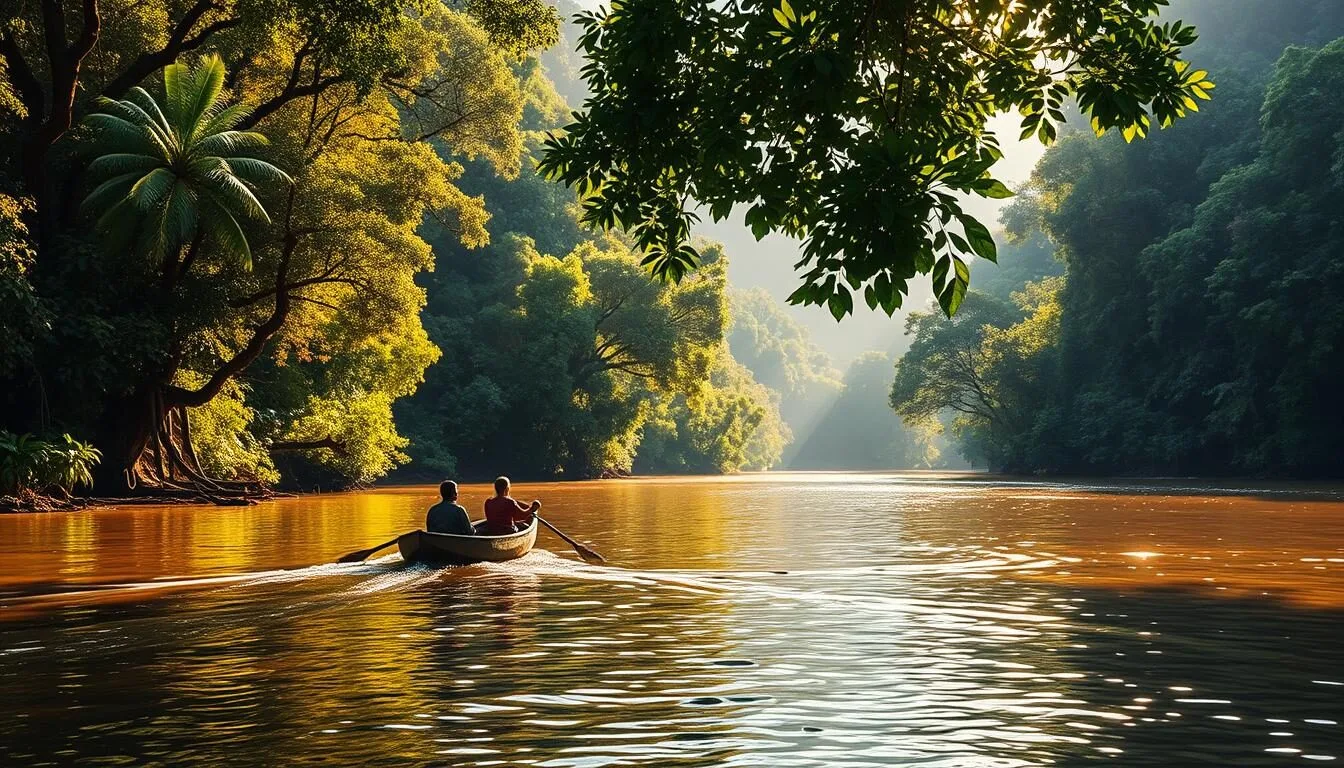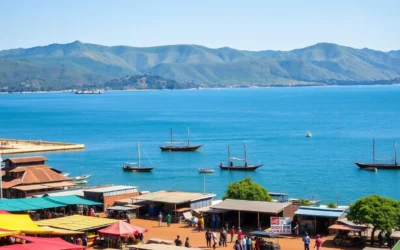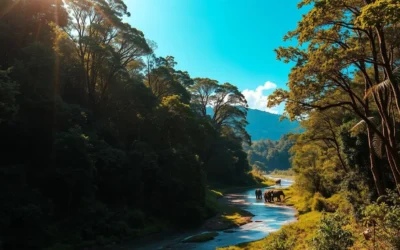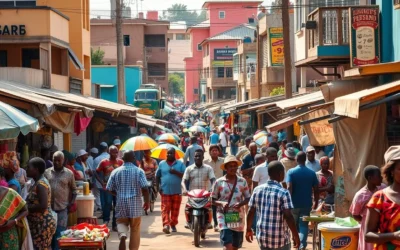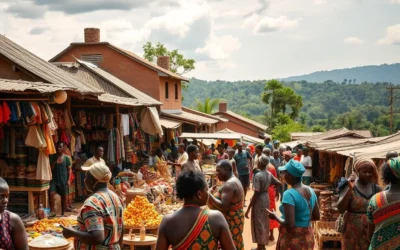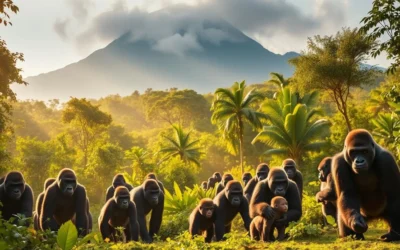✓ Accommodations ✓ Flights ✓ Rental Cars
Nestled at the furthest navigable point on the Congo River, Kisangani is a city that offers a truly unique travel experience. With over 250 cultures represented, you’re in for an authentic African adventure.
Founded by Henry Morton Stanley in 1883, this city has a rich history and a blend of cultures that will captivate you. From the magnificent Boyoma Falls to the historic Kisangani Cathedral, there’s much to explore.
As you wander through the vibrant local markets and experience the city’s unique nickname, “the city on the island,” you’ll understand why Kisangani is a must-visit destination in the heart of the Congo Basin.
Discovering the Heart of the Congo Basin
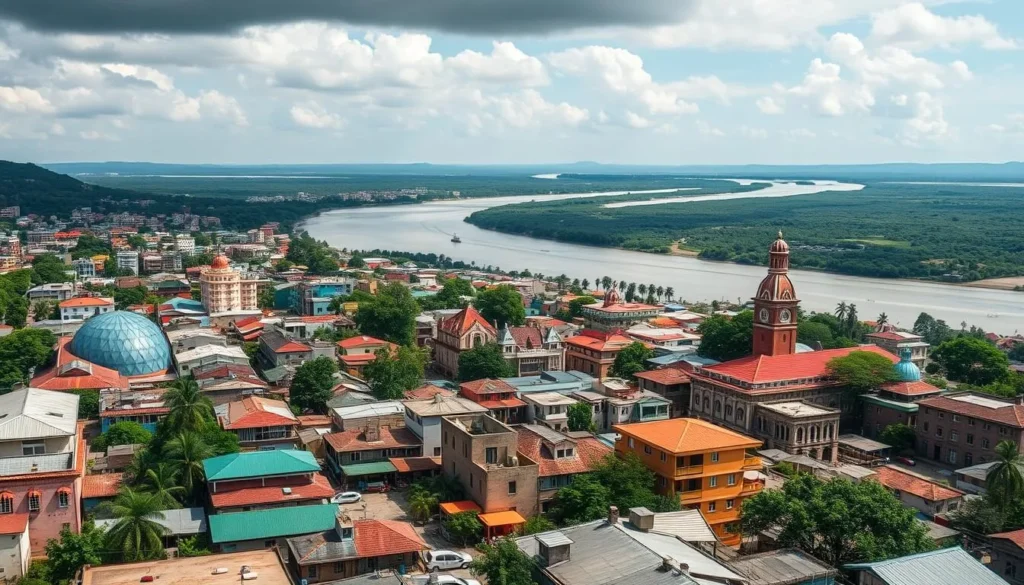
As you step into Kisangani, you’re immediately immersed in the vibrant heart of the Congo Basin. This city, formerly known as Stanleyville, is the third largest in the Democratic Republic of the Congo and serves as the capital of the vast Orientale Province.
The City’s Strategic Location on the Congo River
Kisangani’s unique position at the furthest navigable point on the Congo River upstream of Kinshasa/Brazzaville makes it a crucial hub for trade and transportation. The city’s location at the end of the Boyoma Falls, a series of cataracts along a 100-km stretch of the river, has shaped its development as a major commercial center.
The Congo River plays a vital role in the city’s life, supporting local industries and facilitating the exchange of goods. You can experience the significance of this waterway firsthand by exploring the city’s riverfront and observing the bustling activity.
A Brief History of Kisangani
Kisangani’s history is as rich as it is complex, with roots dating back to its founding by Henry Morton Stanley in 1883 as Stanley Falls Station. The city evolved significantly during the Belgian rule, leaving behind a legacy that is still visible in its architecture and cultural practices.
The name “Kisangani” comes from Swahili, meaning “the city on the island,” due to the tributaries that almost completely separate the city into a collection of islets. This unique geography has contributed to the city’s cultural diversity, with over 250 ethnic groups represented in its vibrant life.
Exploring Boyoma Falls: Kisangani’s Natural Wonder
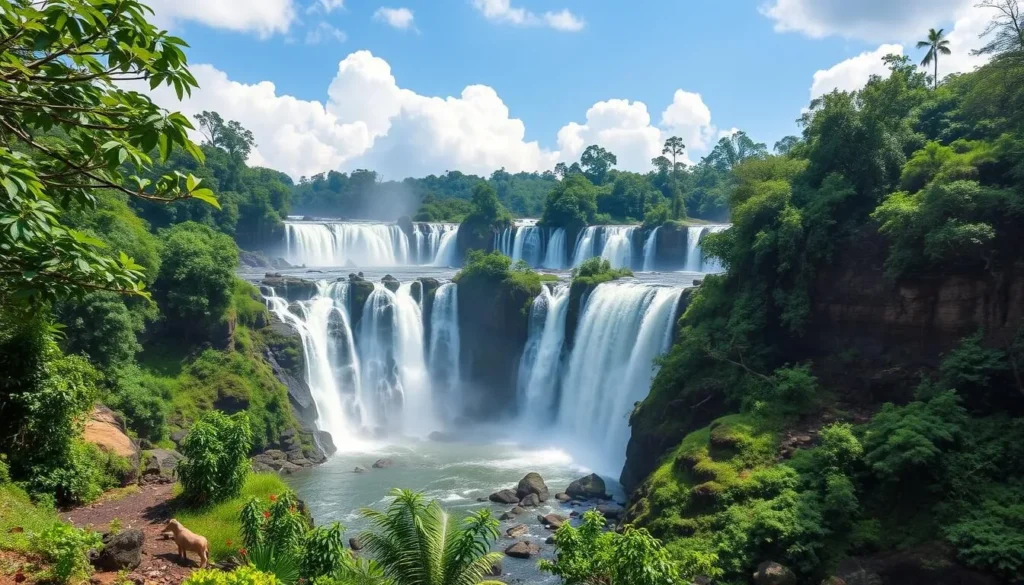
As you approach Kisangani, the majestic Boyoma Falls comes into view, a breathtaking natural wonder that showcases the power of the Congo River. Boyoma Falls is a series of seven cataracts stretching over 100 km along the Congo River, representing the last major falls before the river becomes navigable all the way to Kinshasa.
Witnessing Traditional Fishing Techniques
The Wagenia fishermen at Boyoma Falls are known for their ingenious traditional fishing techniques. They construct and maintain elaborate wooden scaffolding and conical basket traps to catch fish in the powerful rapids. You can witness these traditional methods, which have been passed down through generations, showcasing the deep connection between the local people and the mighty Congo River.
Best Times to Visit the Falls
The best time to visit Boyoma Falls is during the drier months (December to February), when water levels are lower and the wooden structures of the fishermen are more visible. Be prepared for a cultural experience when interacting with local fishermen, who now recognize the tourism value of their traditional practices and may charge around $20 for viewing and photography privileges.
As you marvel at Boyoma Falls, you’ll appreciate the natural power and beauty of the falls, creating a spectacular landscape that you’ll see nowhere else in the Democratic Republic of the Congo. This experience will give you a deeper understanding of the region’s unique natural wonders and the importance of preserving traditional practices.
Visit the Historic Kisangani Cathedral
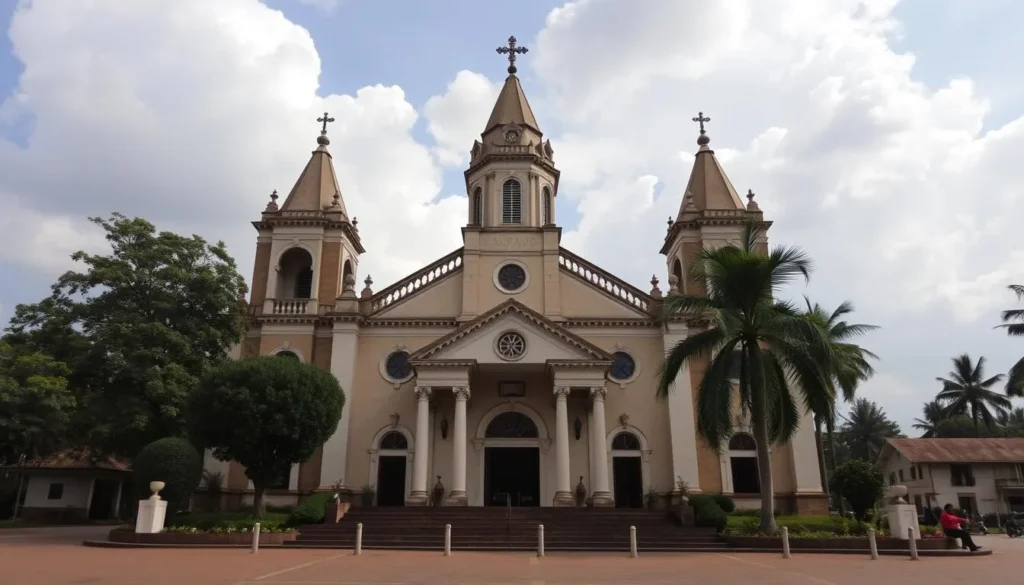
As you explore Kisangani, you’ll discover the historic Our Lady of the Rosary Cathedral, a significant landmark in the Democratic Republic of the Congo. This impressive structure is not only a place of worship but also a testament to the city’s rich history and cultural heritage.
Architectural Highlights
The Kisangani Cathedral boasts a distinctive architectural style that blends European design elements with local influences, creating a unique structure that reflects the city’s colonial past. As you admire the cathedral’s exterior, notice the intricate details and the way it has been adapted to the local climate.
Cultural Significance
The cathedral serves as a vital spiritual center for Kisangani’s Catholic community, playing a significant role in the religious life of the city. It has witnessed the city’s tumultuous history, from its days as the capital of the Eastern Province during Belgian colonial rule to the present, standing as a symbol of resilience and continuity for the people of Kisangani.
By visiting the Kisangani Cathedral, you’ll gain a deeper understanding of the city’s history, cultural heritage, and the importance of this landmark in the heart of the Democratic Republic.
Congo River Cruises and Boat Experiences
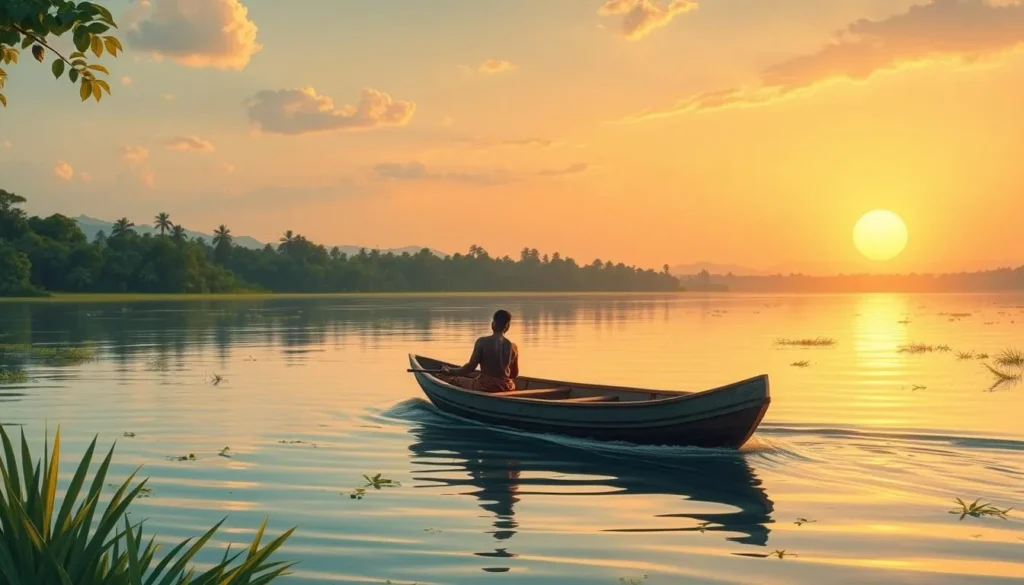
Embark on a journey along the majestic Congo River, where the heartbeat of Africa pulses through its waters. The Congo River is not just a waterway; it’s a gateway to experiencing the raw beauty and vibrant culture of Kisangani.
Day Trips on Traditional Pirogues
Experience the magic of the Congo River with day trips on traditional pirogues. As you glide along the river, you’ll witness local life unfold along the riverbanks, gaining a unique perspective of Kisangani from the water. The Congo River has shaped Kisangani’s development as a major port city, serving as the furthest navigable point upstream from Kinshasa.
You’ll see fishermen at work, children playing by the river, and women doing their daily chores, all while enjoying the spectacular views of the lush rainforest and riverside villages.
Longer River Expeditions
For the more adventurous, consider longer river expeditions, which can range from multi-day journeys to the epic 2-3 week ferry trip between Kisangani and Kinshasa. These journeys offer an authentic way to experience the mighty Congo River and its diverse wildlife.
Traveling by pirogue or larger vessels, you’ll be immersed in the local culture and have the opportunity to interact with the communities along the river. Whether it’s a day trip or a longer adventure, your experience on the Congo River will be unforgettable.
Immerse Yourself in Local Markets
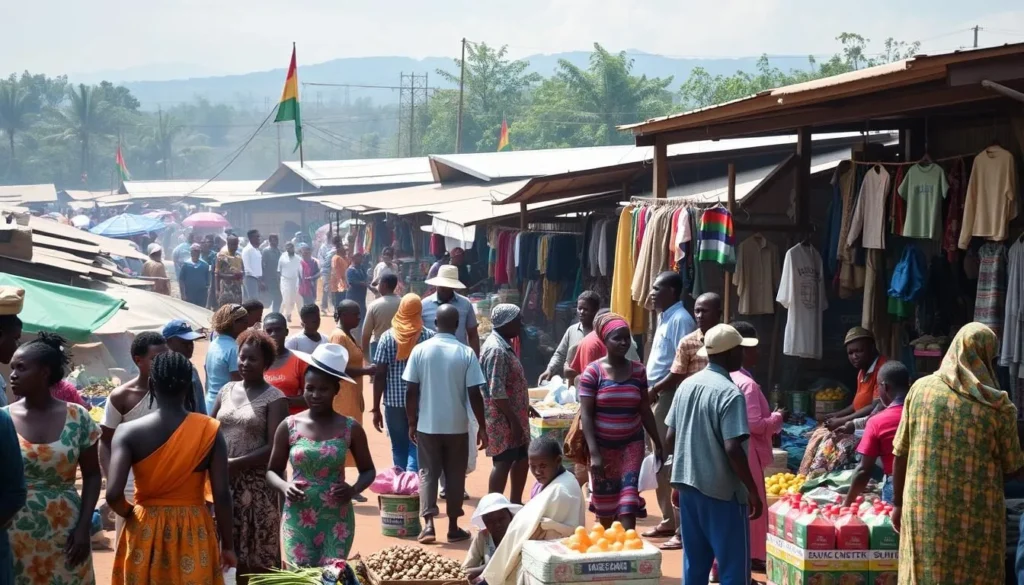
The local markets of Kisangani offer a sensory experience like no other in the Democratic Republic of Congo. As you navigate through the narrow aisles, you’ll be surrounded by a kaleidoscope of colors, sounds, and aromas. The market is a hub where locals gather to buy and sell everything from fresh produce to handcrafted items, reflecting the city’s rich cultural heritage.
Central Market Shopping Experience
Dive into the vibrant atmosphere of Kisangani’s central market, where you can discover a variety of fresh tropical fruits, vegetables, nuts, and street food. The city’s food supply is heavily dependent on barge deliveries, making the market a crucial part of daily life. Interact with friendly local merchants and practice your bargaining skills, as haggling is an expected part of the shopping experience.
Finding Unique Souvenirs
As you explore the market, hunt for unique souvenirs that reflect the rich cultural heritage of the region. You can find handwoven baskets, wooden carvings, colorful textiles, or locally produced coffee. These items not only serve as memorable souvenirs but also give you a deeper understanding of the people and their culture. The market serves as a social hub where people from different walks of life come together, offering a glimpse into the everyday life and community dynamics of Kisangani.
Kisangani, Democratic Republic of the Congo: Best Things to Do for Nature Lovers
As a nature lover, you’ll find Kisangani, Democratic Republic of the Congo, to be a hidden gem, offering unparalleled opportunities to explore the Congo Basin’s rich biodiversity. The city’s strategic location surrounded by the lush rainforest makes it an ideal base for exploring one of the world’s most significant ecosystems.
The Congo Basin rainforest, the second-largest tropical rainforest globally, plays a crucial role in regulating the global climate. Visitors can embark on day trips to nearby forest reserves to witness the incredible array of unique plants and animals that thrive in this equatorial environment.
Exploring the Surrounding Rainforest
The rainforest surrounding Kisangani is a treasure trove of biodiversity, with numerous opportunities for guided tours and trekking adventures. Local guides are knowledgeable about the forest’s intricate ecosystem, helping visitors spot a variety of wildlife, including monkeys, tropical birds, and reptiles.
One of the highlights of exploring the surrounding rainforest is the chance to visit Virunga National Park, a UNESCO World Heritage site located in the eastern part of the Democratic Republic of the Congo. Although a bit of a journey from Kisangani, the park offers an unforgettable experience, including gorilla trekking to see mountain gorillas in their natural habitat.
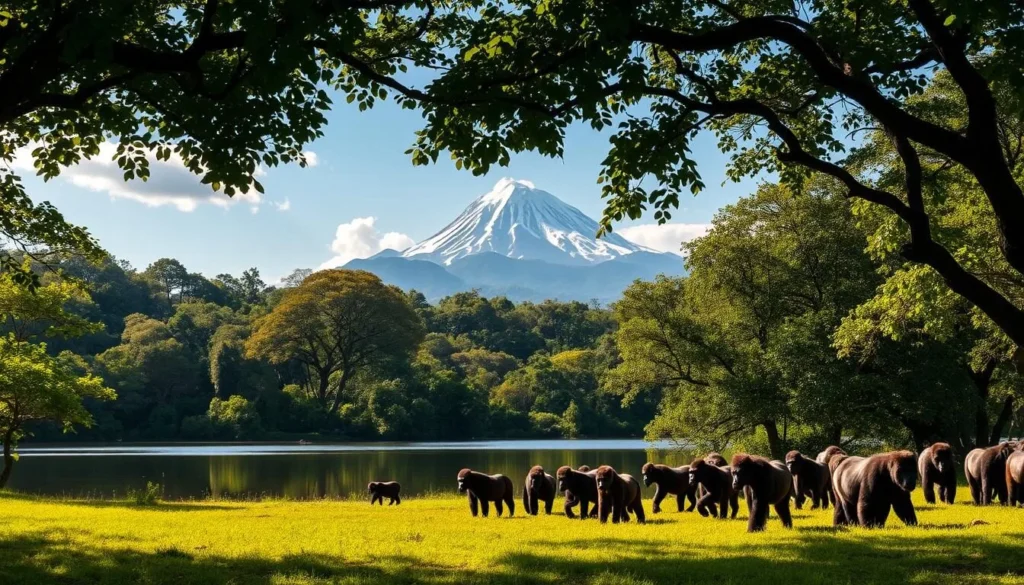
Wildlife Spotting Opportunities
Kisangani and its surroundings offer numerous wildlife spotting opportunities. From the comfort of a guided tour, visitors can explore the forests and waterways to catch glimpses of the region’s diverse fauna. The Congo River itself is home to a variety of aquatic life, and the surrounding forests are inhabited by a wide range of animals.
| Location | Wildlife | Activities |
|---|---|---|
| Congo Basin Rainforest | Monkeys, Tropical Birds, Reptiles | Guided Tours, Trekking |
| Virunga National Park | Mountain Gorillas | Gorilla Trekking |
| Congo River | Aquatic Life | River Cruises |
Conservation efforts are in place to protect the region’s biodiversity, including initiatives within Virunga National Park. By visiting these areas, tourists contribute to the local economy and support conservation efforts, making their trip not only memorable but also impactful.
Discover the Villa of the “African Queen”
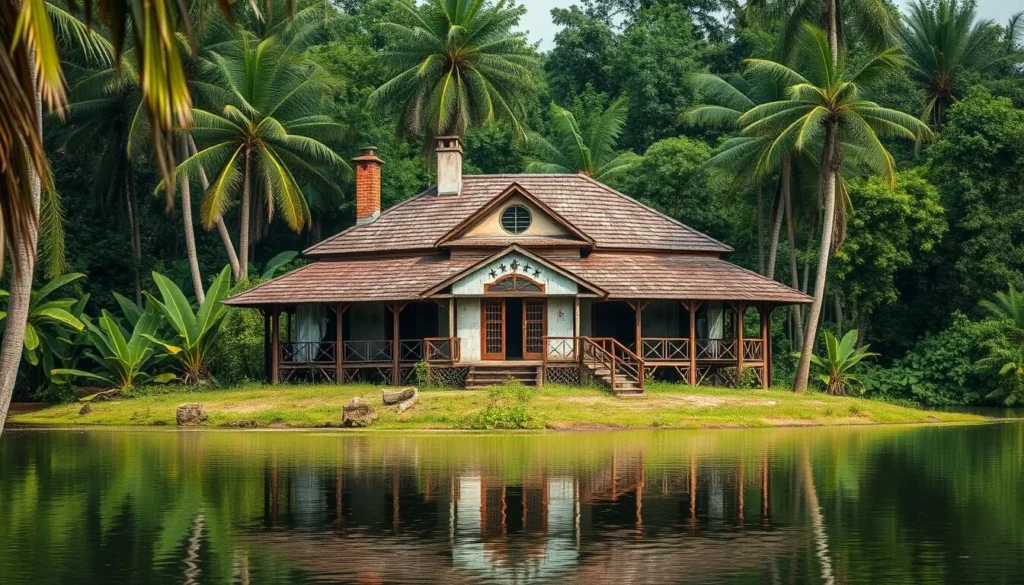
On one of Kisangani’s picturesque islets stands a crumbling villa that once hosted Hollywood stars. This historic villa is a significant landmark in the city, connecting Kisangani to world cinema history.
The Hollywood Connection
The villa’s history is deeply intertwined with the classic 1951 film “The African Queen,” starring Katharine Hepburn, Humphrey Bogart, and Lauren Bacall. The actors stayed at this very villa during filming in the Democratic Republic of Congo, adding to its Hollywood allure.
Current State and Visiting Information
Today, the villa stands as a poignant reminder of the city’s past and the passage of time. To visit this piece of cinema history, you’ll need to take a boat trip to the island, adding an element of adventure to your exploration. The villa’s current state is a testament to the region’s rich history, making it a unique place of interest beyond the typical attractions in the Democratic Republic of Congo.
Experience Kisangani’s Vibrant Cultural Scene
As you wander through the bustling streets of Kisangani, you’ll discover a city that’s alive with the rhythms and colors of its diverse cultural heritage. With over 250 ethnic cultures represented, the city’s cultural scene is a rich tapestry of artistic expressions.
Local Music and Dance
The energetic rhythms of local music fill the air, blending traditional Congolese sounds with modern influences to create a unique soundtrack to city life. You’ll witness traditional dance performances that tell stories of the region’s history and showcase the incredible talent and physical prowess of local dancers.

Cultural Festivals and Events
Kisangani hosts various cultural festivals throughout the year, celebrating everything from harvests to historical events important to the people of Kisangani. These festivals are a testament to the city’s resilience and community spirit.
| Cultural Event | Date | Description |
|---|---|---|
| Harvest Festival | August | Celebration of the harvest season with traditional music and dance. |
| Historical Commemoration | October | Commemoration of historical events with cultural performances and exhibitions. |
By engaging with local artists and craftspeople, you’ll gain a deeper understanding of Kisangani’s unique cultural identity and the ways in which music, dance, and art serve as forms of resilience and community building.
Day Trips to Surrounding Villages
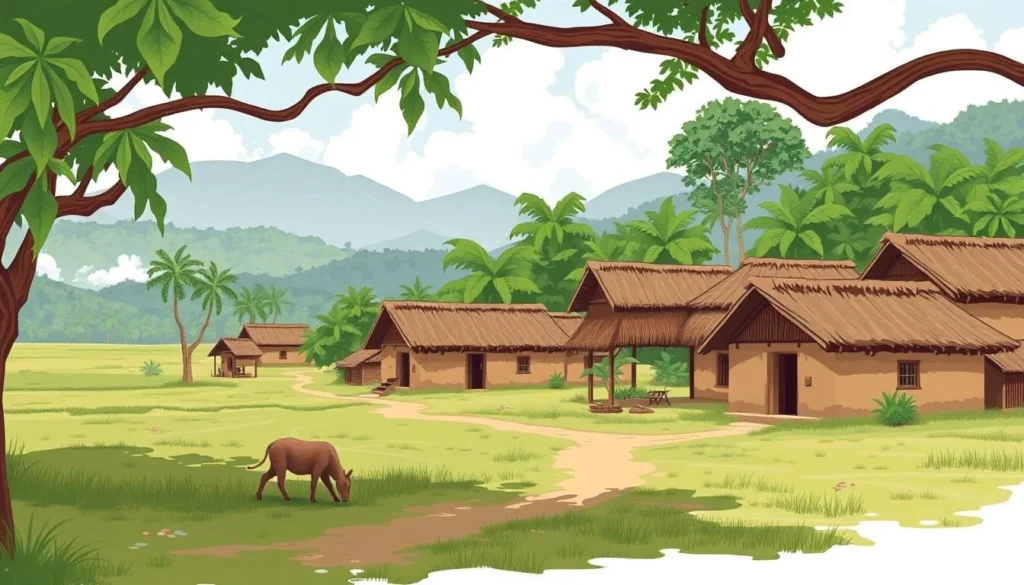
Explore the authentic village life surrounding Kisangani on enriching day trips. These excursions offer a unique opportunity to connect with local communities who maintain traditional ways of life along the Congo River and in the surrounding rainforest.
Meeting Local Communities
You’ll gain insights into the daily routines, challenges, and celebrations of the local people. The warm hospitality of village communities makes for a memorable experience, with shared meals and cultural exchanges creating meaningful connections.
Learning Traditional Crafts
Participate in hands-on workshops where you’ll learn traditional crafts such as basket weaving, pottery making, or fabric dyeing from skilled artisans. These communities have preserved their techniques for generations, offering a glimpse into a rich cultural heritage.
By arranging your village visits through reputable local guides, you ensure that your trip is both respectful and beneficial to the people you meet. This approach supports sustainable tourism and fosters a deeper understanding of the local way of life.
Culinary Adventures in Kisangani
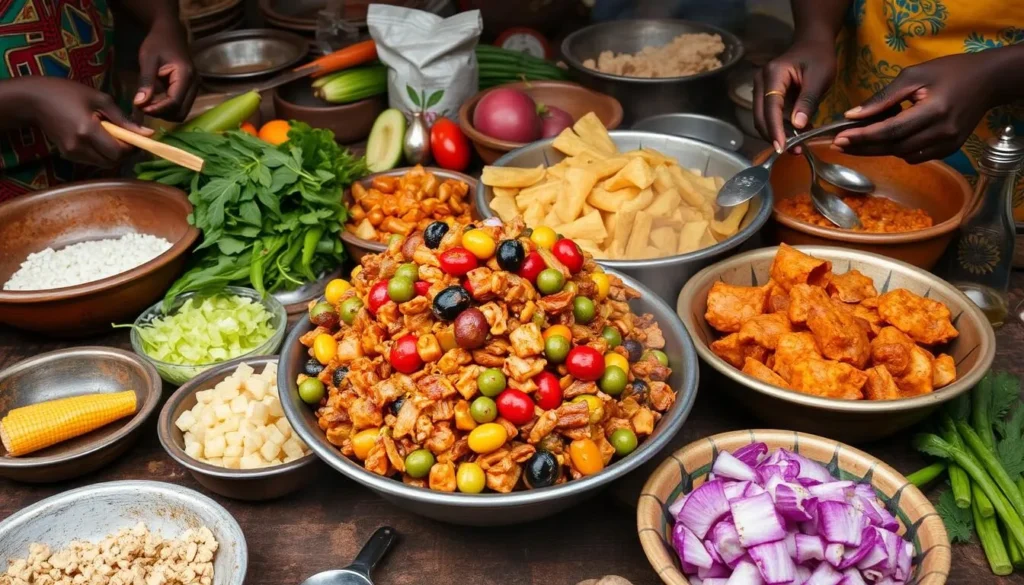
The culinary scene in Kisangani is a vibrant reflection of the Democratic Republic of Congo’s diverse agricultural bounty and traditional cooking methods. As you explore the city, you’ll have the opportunity to sample local delicacies that showcase the region’s rich flavors.
Local Delicacies to Try
Kisangani offers a variety of traditional dishes that are both flavorful and reflective of the local culture. You should try fufu, a staple made from cassava or plantain flour, often served with pondu, which are cassava leaves cooked with palm oil. Fresh fish from the Congo River, prepared with local spices and techniques, is another must-try.
Best Dining Spots
While dining options in Kisangani can be limited, with the city’s food supply heavily dependent on barge deliveries, there are still some great places to enjoy local cuisine. Street food stalls are a great way to experience authentic Congolese dishes like grilled fish and chicken. For a more formal dining experience, the few established restaurants in the city offer a mix of local and international cuisine, albeit at a higher price.
As you enjoy your culinary adventure in Kisangani, be sure to try some of the local beverages, including Congolese beer and palm wine, perhaps at a scenic spot like Linoko Beach.
Where to Stay in Kisangani
Accommodation in Kisangani varies, with some hotels standing out from the rest. When visiting this city in the Democratic Republic of Congo, you’ll find that the top hotels offer modest but comfortable amenities.
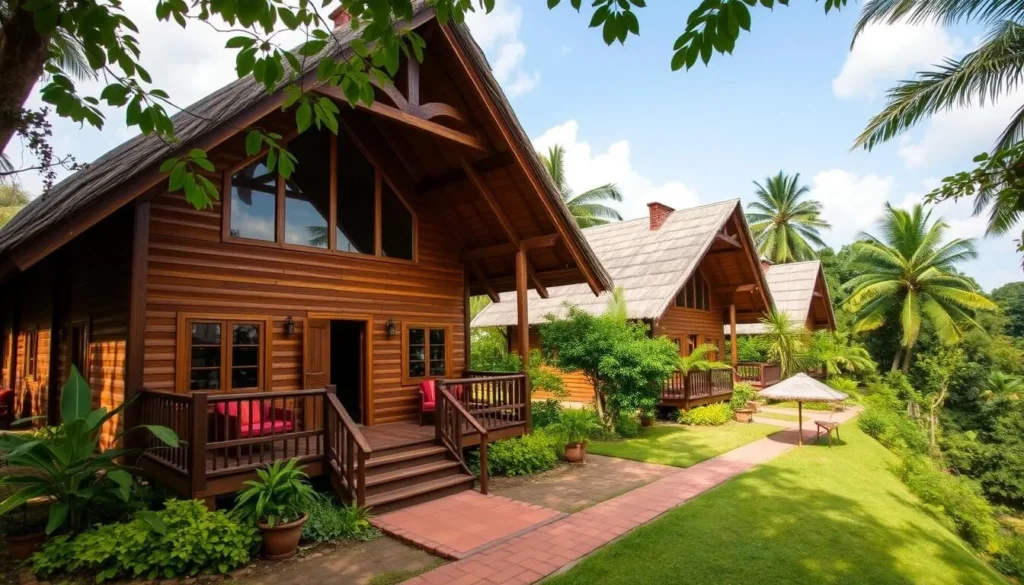
Les Chalets Hôtel
Les Chalets Hôtel, located at 4 Rue de l’Industrie, is one of the top choices for travelers. It offers comfortable amenities, including satellite TV, air conditioning, refrigerators, hot water, a swimming pool, and limited internet access near reception. This hotel provides a relatively comfortable stay, considering the challenges faced by the city.
Palm Beach Hôtel
Palm Beach Hôtel on Avenue Colonel Tshatshi is another highly recommended option. It features air conditioning, television, a swimming pool, and an on-site restaurant and bar, making it convenient for guests. While luxury options are scarce in Kisangani, these hotels offer the best available amenities.
It’s essential to note that even the best hotels in Kisangani have modest facilities compared to international standards. Travelers should be prepared for this and consider contacting hotels directly to confirm their current conditions and availability.
Practical Tips for Visiting Kisangani
When planning your trip to Kisangani, it’s essential to consider several practical aspects to make the most out of your visit. Understanding the local climate, transportation options, and safety conditions will help you navigate this unique city in the Democratic Republic of Congo.
Best Time to Visit
The best time to visit Kisangani is during the relatively dry season, from December to early March. January is the driest month, with just 53mm of rain, making outdoor activities more enjoyable. You should pack lightweight, breathable clothing and rain gear due to the tropical climate with high humidity averaging 86% year-round.
Safety Considerations
Researching current safety conditions before and during your trip is crucial, as the security situation can change rapidly in certain regions of the Democratic Republic of Congo. Arrange necessary permits and documentation well in advance, including visas and any special permissions needed for specific activities or areas you plan to visit.
Getting Around the City
Given the city’s isolation and relatively difficult routes, there are few vehicles in Kisangani aside from cheap motorbikes. Most locals get around on foot or use bicycles. You can consider using motorbike taxis for shorter trips if you’re comfortable with this mode of transportation. It’s also advisable to bring sufficient cash in US dollars, as ATMs are unreliable and credit cards are rarely accepted.
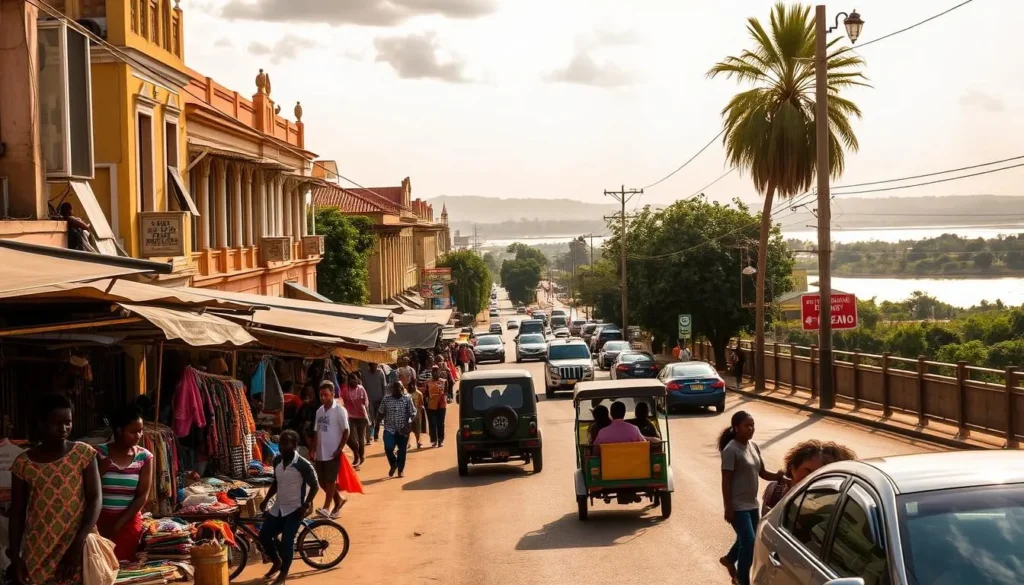
Conclusion: The Unique Appeal of Kisangani
As you conclude your journey through Kisangani, the essence of the Democratic Republic of Congo unfolds. This city offers an authentic experience far from the beaten tourist path. You gain insights into the challenges and resilience of urban life in central Africa. Kisangani’s raw authenticity, vibrant markets, and cultural encounters make it a special place. Your trip here is an education, allowing you to witness a part of the world that few outsiders ever experience.
The above is subject to change.
Check back often to TRAVEL.COM for the latest travel tips and deals.
